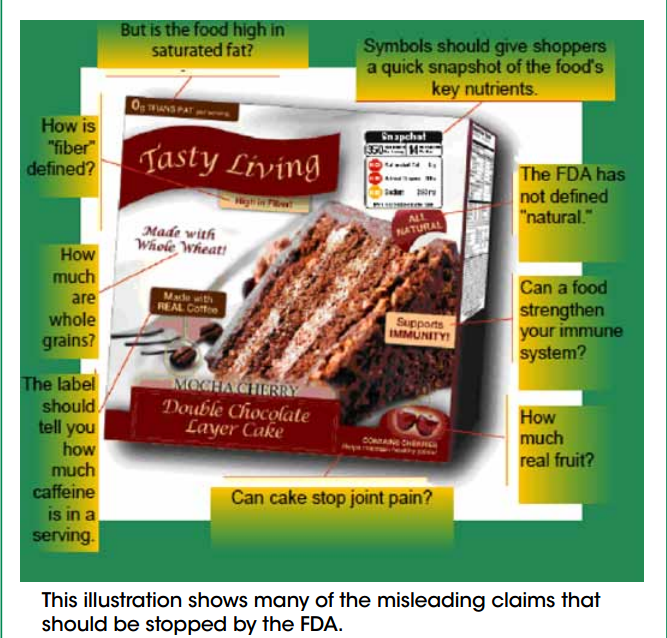Food Labels: The Chaos of Supermarket Marketing
 Walk along any aisle of your local supermarket and you will be overwhelmed with options. Packages of hundreds of different products beckon out to you, claiming to “promote health” and be “all natural” or promising to contain “no added hormones” and “0 Trans fat”. How, with all of these equally ambiguous options, can you go about the daunting task of picking the right product from the bunch?
Walk along any aisle of your local supermarket and you will be overwhelmed with options. Packages of hundreds of different products beckon out to you, claiming to “promote health” and be “all natural” or promising to contain “no added hormones” and “0 Trans fat”. How, with all of these equally ambiguous options, can you go about the daunting task of picking the right product from the bunch?
Some of you might just pick the cheapest variety, but many of you might be thinking “Hey, I want something actually good for me!” and choose the product that offers the largest quantity of healthful sounding claims.
And that would be a good strategy if it were not for the fact that when it comes to food labels and certifications, I like to paraphrase my good friend Inigo Montoya.
You keep buying food with those labels. I do not think they mean what you think they mean.”
The truth is, most claims made on food packages have little to no regulation. Simply put, food companies can say almost anything about their products and face no scrutiny by the FDA. Here is a handy example of all of the erroneous health benefits claimed by a piece of cake.

Image from Food Labeling Chaos Report
Many of the labels that are common on different food products such as “all natural” actually have no formal definition of ingredients or measure of healthiness, which means that your “all-natural” potato chips are likely no different than a rival brand without this meaningless label.
The rules on claiming health benefits are also pretty hazy. One of the clearest examples of this can be found in foods claiming fiber content. The Food Labeling Chaos Report (pg 29) explains
“These products do not contain the traditional sources of fiber associated with health benefits.”
Instead, high fiber products – such as granola bars, cereals, and even ice cream – often add “isolated fibers“, a manufactured, powdered substance that has little to no link to the health benefits of traditional fibers found in whole grains.
So, now that you know that all of your favorite packaged foods have been lying to you, you may be wondering how to actually go about making healthy choices while grocery shopping.
Following these 4 general guidelines will help you shop smarter.
 1. Go Raw
1. Go Raw
The easiest way to avoid unknowingly consuming junk is to avoid processed foods altogether. If you eat an apple, you are eating an apple. If you eat an all-natural apple pie breakfast bar with low-fat and 10% of your daily fiber plus it will boost your immunity, you are eating lies. No matter how “healthy” the processed option might sound, the raw option is always better.
2. Get To Know Your Labels
As discussed above, many many of the labels you will find of food packages are misleading at best. That said, some of the labels you will find, like these winners, actually do follow clear regulations. Becoming educated on what means what is a major step towards shopping smart.
 3. Read The Ingredients
3. Read The Ingredients
Food packaging can lie to you all it wants, but when it comes to the list of ingredients companies have to be honest. Reviewing these ingredients can cue you in to what is actually in the food you’re buying, and reveal that the “low-fat” cookies you’re eating happen to also be packed with sugar. Generally speaking, the less ingredients sound like English, the more processed they are, and the worse they are for you.
4. Use Common Sense
We as a society have made huge advancements in technology and health, but as of yet we have still not found the secret to making cake healthy. Please understand I’m not trying to forbid you from ever eating baked goods again (I am currently eating a bagel). I just want to remind everyone that a piece of cake is still cake regardless of how much a company claims it could also possibly have some health benefits.
Just remember that if the claim a food product is making seems too good to be true, it probably is.
In today’s culture where food and toys are marketed with the same tactics and the definition of “healthy” changes with each new study, it can be difficult to know what to believe. But by staying educated of food labeling regulation and using common sense, you too can navigate the once overwhelming aisles of the supermarket with confidence, knowing what you are looking for and how to find it.
Want to read more about the chaos of food labeling? Click here
